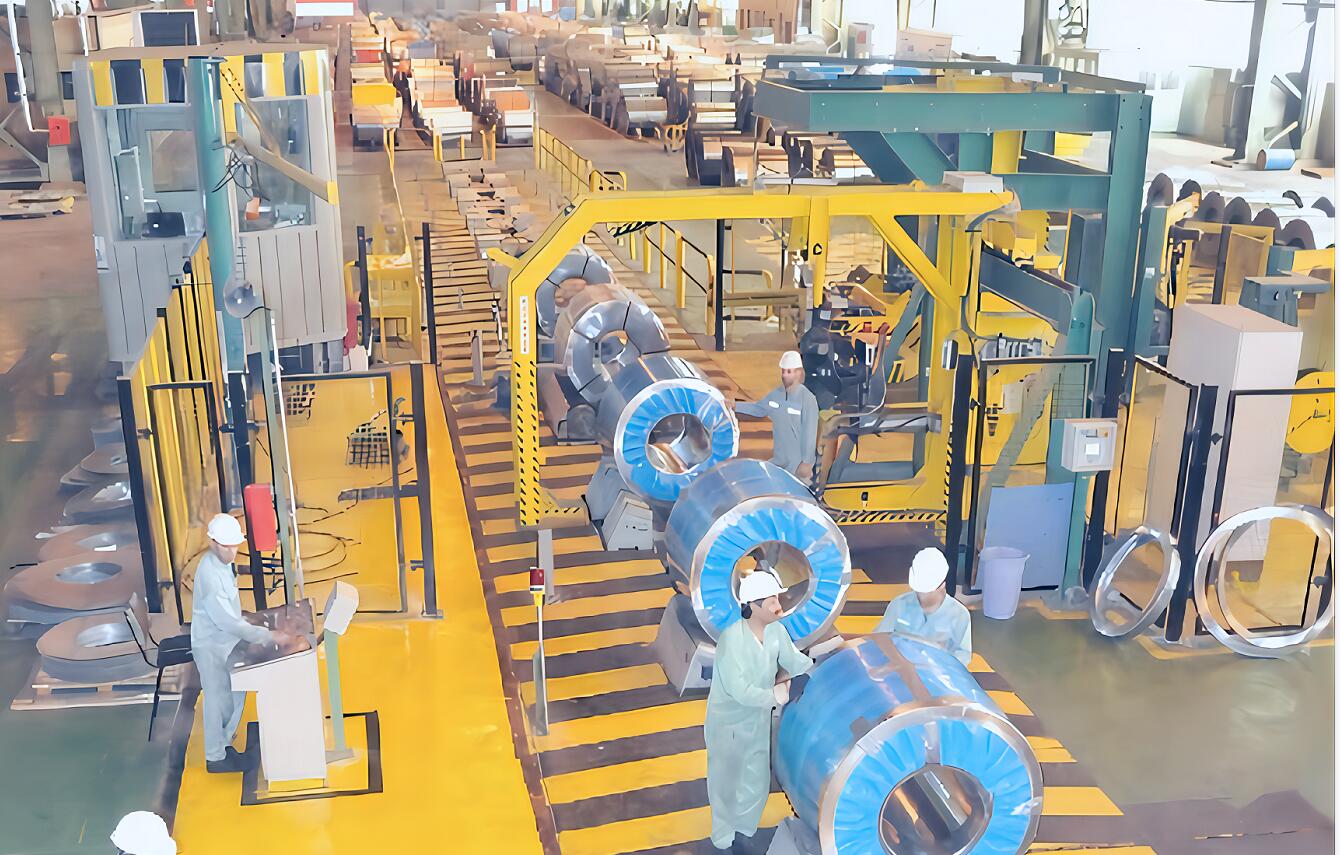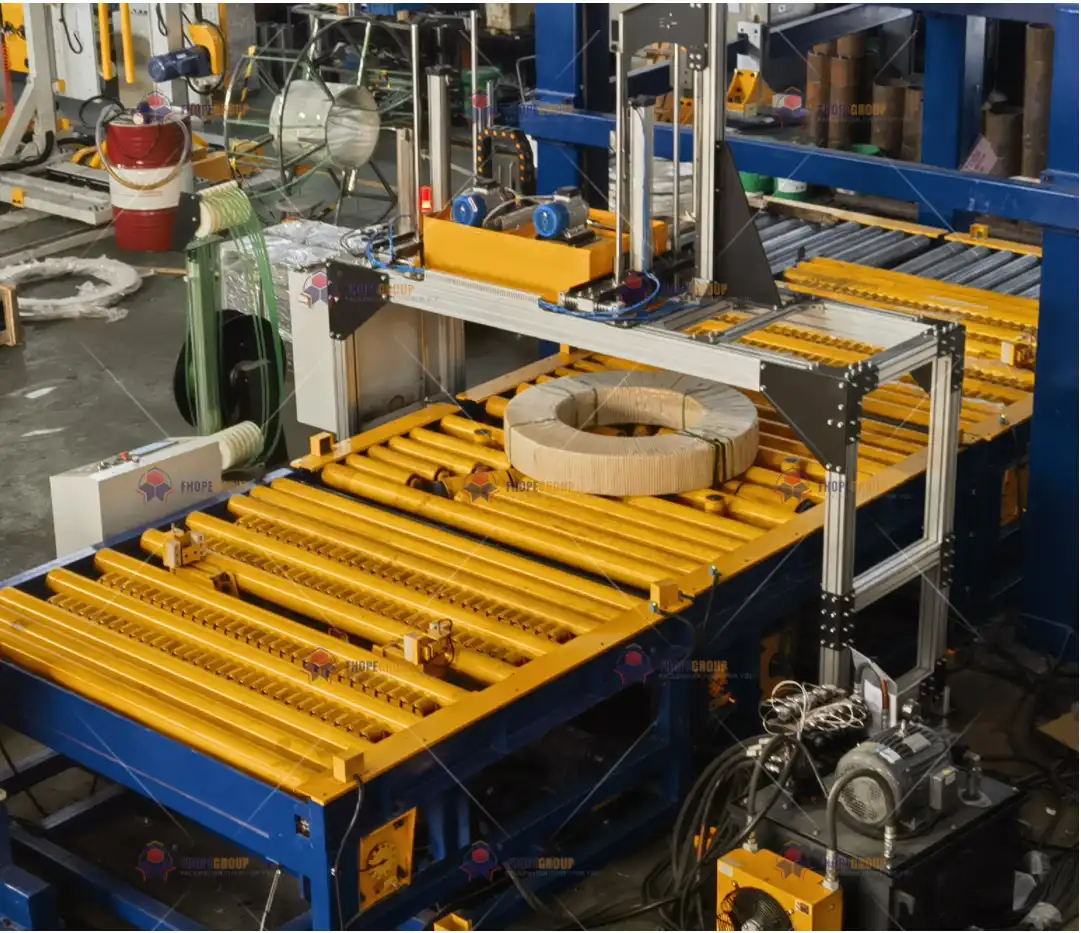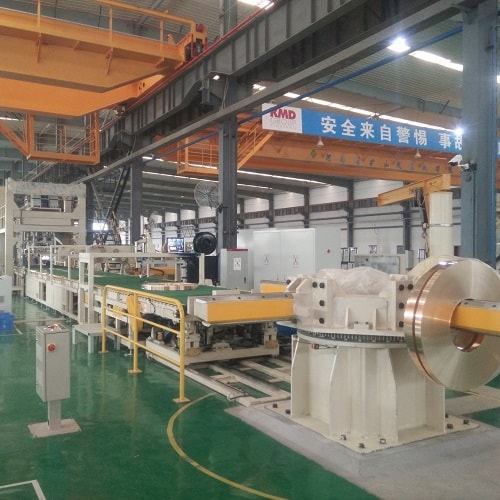Unplanned downtime is one of the biggest challenges for any steel plant manager in Canada. You have a target to hit, and suddenly, a breakdown on the coil packing line brings everything to a halt. It's frustrating. This single point of failure creates a ripple effect across your entire operation, causing delays, increasing costs, and putting pressure on your team. It feels like you are constantly solving problems instead of moving your business forward. But it does not have to be this way. By focusing on smarter coil handling and packing solutions, you can turn this major bottleneck into one of your most reliable assets.
Smarter coil handling solutions reduce downtime in Canadian plants by replacing aging, failure-prone equipment with integrated, automated systems. These modern lines incorporate robust machinery, predictive maintenance sensors, and efficient workflows. This minimizes manual errors, accelerates the packing cycle, and prevents unexpected breakdowns, leading to a direct and significant increase in plant uptime and productivity.

This might sound like a simple fix, but the impact is profound. I have seen it transform operations time and time again. The journey to reducing downtime isn't just about buying a new machine; it's about adopting a new, more intelligent approach to a critical part of your production. Let’s explore how these smart solutions work in the real world and what they can mean for your plant's bottom line.
How Can Upgrading Your Coil Handling Line Directly Impact Plant Uptime?
You know the feeling. Your coil packing line is over 15 years old, and the small, frequent stops are starting to add up. A sensor fails, a chain slips, a pneumatic part gives out. Each thirty-minute delay feels minor, but they disrupt the entire rhythm of your mill. These small issues create constant stress for your maintenance team. They also create a significant drain on your production schedule and overall output. A modern, integrated coil handling system is designed very differently. Its purpose is to create a smooth, continuous flow from the slitter to the warehouse, eliminating the weak points that cause these nagging interruptions.
Upgrading your coil handling line directly boosts plant uptime by swapping old, unreliable mechanical components with durable, automated systems. This drastically cuts down how often breakdowns happen. A modern line also moves faster, meaning each coil is packed and ready in less time. This speed creates a valuable buffer in your production process, making your entire plant more resilient to delays from other areas.

The Shift from Reactive to Proactive Operations
An old handling line forces your team to be reactive. You wait for something to break, then you rush to fix it. This is the definition of downtime. A modern system, however, is built for proactive management. It is about preventing failures before they happen.
I remember a client in Ontario whose team spent nearly ten hours a week on emergency maintenance for their old packing line. The line used a complex system of hydraulic lifts and chain conveyors. It was slow, and something was always leaking or misaligned. After we designed and installed a new line based on electric servo motors and intelligent conveyors, their situation changed completely. The new system included sensors that monitored motor temperature and vibration. The control panel would alert the maintenance manager if a motor's performance changed even slightly, long before it could fail. This allowed them to schedule maintenance during planned shutdowns. Their unplanned downtime on that line dropped to almost zero within three months.
Integration as a Key to Smooth Flow
True integration is more than just connecting machines together. It is about making them communicate intelligently. In a smart line, the coil car "knows" when the wrapping station is ready. The wrapping machine tells the strapping machine the exact dimensions of the coil it just packed. The strapping machine confirms the cycle is complete before the conveyor moves the coil to the stacking unit. This constant communication eliminates jams, crashes, and waiting time between steps. Each component works in harmony with the others, maximizing the speed and efficiency of the entire process. This seamless flow is a fundamental way that modern lines increase uptime. You are not just speeding up one step; you are optimizing the entire sequence.
| Feature Comparison | Old Coil Handling Line | Modern "Smart" Coil Handling Line |
|---|---|---|
| Core Technology | Hydraulic, Pneumatic, Chain-Driven | Electric Servo-Driven, Integrated PLC |
| Breakdown Frequency | High (Weekly Incidents) | Very Low (Predictable Maintenance) |
| Maintenance Type | Reactive (Fix after failure) | Proactive (Predictive alerts) |
| Integration | Minimal; Manual hand-offs | Fully Integrated; Machine-to-machine comms |
| Average Uptime | Often below 85% | Consistently above 95% |
| Operator Input | High; Constant supervision needed | Low; Automated cycles, central control |
What Are the Hidden Costs of Outdated Coil Packing Automation?
When you look at your old packing line, you clearly see the direct costs. You see the invoices for replacement parts and the hours your maintenance team spends on repairs. But this is only a small part of the total cost. The real financial damage comes from hidden sources that don't always appear on a spreadsheet. I am talking about wasted packing materials, the risk of safety incidents from excessive manual handling, and product damage from inconsistent wrapping or strapping. These hidden costs quietly eat away at your profitability every single day. A modern system is engineered for precision and efficiency. It uses the exact amount of material needed, operates within strict safety protocols, and protects your valuable steel coils perfectly every time.
The hidden costs of outdated coil packing automation extend far beyond simple repair bills. They include the excessive use of stretch film and steel straps due to inefficient machines, higher labor costs from slow and manual processes, product damage from rough handling, and greater safety risks for your operators. These factors silently reduce your profit margins and represent a huge opportunity for savings.

Quantifying the Unseen Expenses
Let's break down these costs. Early in my career as an engineer, I was asked to analyze a packing line for a large steel processor. Their machine was old but still "working." However, we discovered it was wasting a huge amount of money.
The True Cost of Wasted Materials
Their old orbital wrapper did not have a powered pre-stretch function. This meant it was applying stretch film with very little tension, using far more film than necessary to secure a coil. We calculated that a modern wrapper with a 300% pre-stretch capability would use one-quarter of the film for the same job. For a plant producing thousands of coils a month, this translated into savings of over $100,000 per year on stretch film alone. Similarly, an old strapping head might not apply consistent tension, leading operators to add extra straps "just in case," wasting expensive steel strapping.
The High Price of Inefficiency and Risk
An outdated line also requires more people to run it. You might need one person to guide the coil, another to operate the wrapper, and a third to manage the strapping. A modern, automated line can often be managed by a single operator from a central control panel. This not only reduces direct labor costs but also significantly improves safety. Every time a person has to manually interact with a heavy coil or a moving machine, there is a risk of injury. In Canada, with strong workplace safety regulations, a single incident can have enormous financial and operational consequences. Reducing these manual touchpoints is one of the most important benefits of modern automation.
| Hidden Cost Category | Example in an Outdated Line | Impact of a Modern Solution |
|---|---|---|
| Material Waste | Wrapper with no pre-stretch; extra straps | Up to 75% less film; precise strapping |
| Excess Labor | 2-3 operators for one line | 1 operator for multiple functions |
| Product Damage | Coils scratched during handling; loose wrap | Gentle handling; secure, uniform packaging |
| Safety Risks | Manual strapping; proximity to machinery | Fully guarded; remote operation |
| Energy Consumption | Inefficient hydraulic pumps run constantly | Servo motors use power only when moving |
Why is a 'Strategic Partner' Better Than Just a 'Supplier' for Canadian Steel Mills?
You need to invest in new equipment. So you send out a request for a quote to several companies. You get back a list of prices and technical sheets. The process is time-consuming, and it can be very difficult to compare the different options fairly. You worry that if you choose the cheapest machine, it will cause problems later. Maybe it won't integrate properly with your existing control systems, or the company will disappear once they have your money, leaving you with no support. This is a common fear, and it is a valid one. A true strategic partner operates differently. They invest time to understand your plant, your specific challenges, and your goals for the future. The machine they provide is just one part of a complete solution they build with you.
A strategic partner is better than a simple supplier because they provide a total, long-term solution, not just a product. For Canadian steel mills, this means receiving expert guidance on every stage of the project. This includes initial layout design, integration with your production software, full installation and commissioning, training for your operators, and a plan for long-term maintenance and future upgrades. A partner is invested in your success, not just in making a single sale.

The Partnership Journey: From Concept to Optimization
When I started my own factory, I made a promise to myself. I wanted to build the kind of company that I would have wanted to work with when I was an engineer. This means being more than just a name on an invoice. A partnership is a process.
It starts with consultation. A partner will visit your plant or have detailed discussions to understand your workflow. They will ask about your coil sizes, your production rate, your downstream logistics, and your five-year plan. They are gathering information to design a solution that fits you perfectly. A supplier, in contrast, will often just try to sell you a standard machine from their catalog.
Next comes custom design. Every steel mill is different. A partner uses the information they gathered to engineer a system tailored to your space and your needs. This could mean designing a special conveyor to navigate a tight corner or integrating specific sensors to connect with your MES platform.
After installation, the partnership continues. This includes comprehensive training for your operators and maintenance staff, ensuring they are comfortable and confident with the new equipment. And most importantly, a partner provides long-term support. They are available for troubleshooting, provide spare parts quickly, and can help you plan for future upgrades as technology evolves or your needs change. This continuous relationship is the core difference and the primary source of long-term value.
| Aspect | Standard Supplier | Strategic Partner |
|---|---|---|
| Focus | Selling a machine | Solving a problem |
| Relationship | Transactional, short-term | Collaborative, long-term |
| Scope | Delivers equipment | Delivers a total solution |
| Goal | Make a sale | Ensure client success and ROI |
| Support | Limited to warranty period | Ongoing (training, maintenance, upgrades) |
| Knowledge | Knows their product | Knows your business and their product |
What Is My Core Philosophy for Designing a Truly 'Smart' Coil Handling Solution?
People in our industry talk a lot about "Industry 4.0," "IoT," and "smart factories." These are powerful ideas, but they can also feel very abstract and expensive. As a plant owner, you probably wonder if it's all just marketing buzz. You need practical solutions that give you a clear return on your investment, not just complicated technology for the sake of being modern. My entire approach to designing a "smart" solution is built on this practical foundation. For me, "smart" means using proven technology to solve the real-world challenges you face every day: high costs, unreliability, and inefficiency.
My core philosophy for a smart coil handling solution rests on three simple pillars: absolute reliability, practical data, and flexible design. This means we must first build machines that are mechanically tough and dependable. Then, we add intelligent sensors and software that give you useful, actionable information to improve your operations—not just a flood of confusing data. Finally, the design must be ready for the challenges of tomorrow.

Pillar 1: Reliability is the Foundation of Intelligence
A machine that breaks down is not smart. I don't care how many sensors it has. My design process always begins with the mechanical foundation. I learned this on the factory floor, not from a textbook. We use heavy-duty steel frames, oversized bearings, and high-quality components from globally recognized brands like Siemens and SEW. A smart system must first be a durable system. The intelligence comes from building on a base of rock-solid reliability. If the machine runs consistently for years with minimal issues, that is the first and most important sign of a smart design.
Pillar 2: Data That Serves a Purpose
I do not believe in collecting data just because we can. A smart system should be designed to answer important questions for the plant manager. For example: How many coils did we pack per shift? What is the average cycle time? Is the motor on the main wrapper showing increased vibration that might signal a future failure? This is the kind of practical data that connects directly to the goals of increasing uptime and lowering costs. The information must be presented clearly on a simple HMI screen, so your team can understand it and take action. The goal of data is to enable better decisions, not to create more work.
Pillar 3: Designing for Tomorrow's Challenges
The needs of your business will change. A great solution installed today should not become obsolete in five years. This is why I believe in modular and flexible design. Maybe today, you only need a semi-automated line. But the system should be designed so that in two years, you can easily add a fully automatic strapping machine or connect the entire line to a new data analytics platform. This "future-ready" approach protects your investment. It ensures that the equipment can grow and adapt with your business, whether you are responding to new market demands or stricter environmental regulations.
| My Design Pillar | Core Principle | Benefit for the Plant Owner |
|---|---|---|
| Reliability | Build a mechanically robust machine first. | Maximum uptime, less maintenance, peace of mind. |
| Practical Data | Collect only actionable information. | Clear insights to improve efficiency and predict failures. |
| Flexible Design | Use a modular, upgradable architecture. | Protects the investment; adapts to future needs. |
Conclusion
Reducing downtime isn't just about new machines. It's about a smarter approach. A reliable partner and intelligent design are your keys to unlocking true plant efficiency and growth.

